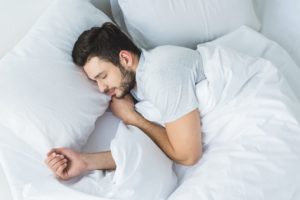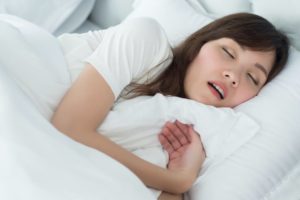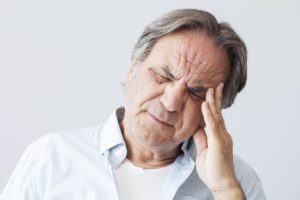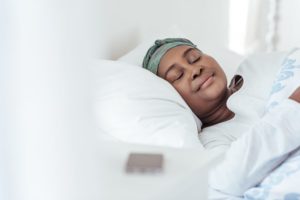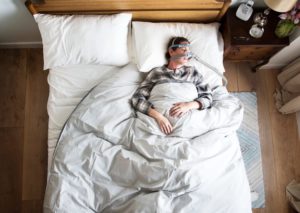Does Sleeping Sitting Up Help Sleep Apnea?
- Sleep position can influence the prevalence and severity of sleep apnea symptoms.
- When sitting up, a person can avoid the effects of gravity narrowing the airways.
- Sleeping upright may benefit those with positional obstructive sleep apnea.
- Try sleeping while sitting upright by using multiple pillows to support your upper body.
About 30 million people in the United States have obstructive sleep apnea (OSA). For half or more of people with OSA, their symptoms may improve or worsen with changes in sleeping position. Sleeping upright or on the side may help people with positional sleep apnea to breathe more easily.
Can Sleeping Upright Help with Sleep Apnea?
When a person sleeps flat on their back, gravity can close or narrow the space at the back of their mouth and upper throat. At the same time, the amount of air they can hold in their lungs drops, as does the volume of air they can exhale. Sleeping upright or on one side can reverse these effects and move structures in the mouth away from the back of the throat.
While around half of people with OSA can benefit from sleeping upright or on their sides, about 20% to 30% of people with sleep apnea only have symptoms while lying on their backs. This is called positional obstructive sleep apnea (POSA). Although definitions of POSA vary, most experts define it as at least a doubling in the apnea-hypopnea index (AHI) while sleeping lying down, compared to sleeping in a different position.
Is Your Snoring a Health Risk?
Answer three questions to understand if you should be concerned.
Benefits of Sleeping Upright
Sleeping upright or on the side, also called positional therapy, can help people whose sleep apnea is worse when they lie flat on their backs. People with POSA typically have fewer symptoms of sleep apnea when they sleep upright than when they sleep flat on their backs.
Research has found that people with POSA who are treated with positional therapy are less sleepy during the day , compared to people with untreated POSA. Sleeping upright or on one side may also raise blood oxygen levels and reduce breathing issues.
However, in most cases, positional therapy should not be the only treatment for obstructive sleep apnea. The American Academy of Sleep Medicine recommends positional therapy as either an addition to positive airway pressure (PAP) or as a second treatment for people who do not respond to their first treatment for sleep apnea.
People who do not tolerate or want CPAP treatment may benefit from positional therapy. Although treatment with CPAP reduces breathing problems more than positional therapy alone, some people may find positional therapy more comfortable or less invasive than CPAP.
Sleeping upright may also improve symptoms of other conditions that can disrupt sleep. Raising the head of the bed or sleeping on multiple pillows can reduce nighttime heartburn in people with gastroesophageal reflux disease (GERD). Sleeping upright may also make it easier to breathe, and therefore sleep, for people with heart failure and fluid build-up in their lungs.
Not all people with OSA have more breathing disruptions when lying on their backs. People who think they may have POSA should talk to a doctor and consider getting a sleep study to confirm their diagnosis before trying positional therapy.
Additional research will be needed to better understand the benefits and risks of positional therapy.
Drawbacks to Sleeping Sitting Up
Sleeping sitting up does not benefit everyone with obstructive sleep apnea, and some people may experience drawbacks from sleeping upright. In studies, the most commonly reported negative effects of positional therapy were discomfort in the back and chest and difficulty sleeping.
Prolonged sitting, such as during an airplane flight, long drive, or after a leg injury, may increase the risk of blood clots in the legs. Some people should discuss blood clot prevention with their doctors before changing their usual sleep position. These include people with a history of blood clots, those who take medicines or have conditions that raise the risk of clotting, and those who will be undergoing major surgery.
Babies less than one year old should never be put to bed on an inclined surface nor on their sides due to the risk of sudden infant death syndrome (SIDS).

How to Sleep Upright With Sleep Apnea
There are several positional therapies, ranging from simple and inexpensive to complex and technical.
Simply sleeping with multiple pillows beneath the head can improve breathing during sleep for some people. Raising the head of the bed—either with a wedge pillow beneath the mattress, blocks beneath the feet of the bed, or an adjustable bed—can also help people sleep upright. Some people who have difficulty breathing at night prefer to sleep on a reclining chair.
People trying to learn how to sleep on their sides have several options as they adjust to a new sleep position. One inexpensive and simple technique involves keeping a tennis ball or similar object in a back pocket or sewn onto the back of pajamas. The sleeper feels uncomfortable if they roll over onto the tennis ball, and this usually prompts them to roll back onto their side.
Other options include specialized backpacks, vests, and items that strap to the waist to keep a sleeper on their side. Newer sleep positioning devices include sensors that strap around the neck or chest and vibrate when a sleeper lies flat on their back until they change to a different position.
Best Sleeping Position for Sleep Apnea
The best sleeping position for a person with sleep apnea is the one in which they can sleep most comfortably and with minimal breathing difficulties. Many people with sleep apnea have more breathing problems when they sleep flat on their backs than when they sleep in other positions.
Sleeping sitting up can lead to fewer breathing disruptions and higher levels of oxygen in the blood of people with OSA. It may also improve some symptoms for people whose OSA is complicated with GERD or heart failure. However, some people may be uncomfortable sleeping upright or have difficulty sleeping in this position.
People with POSA who are unable to sleep sitting up may consider sleeping on one side. Sleeping on one side can lessen the effects of gravity on the structures of the mouth and upper airway and reduce the symptoms of sleep apnea.
People who suspect their OSA symptoms get worse when they lie flat on their backs may want to ask their doctors whether trying a different sleep position could help.

Still have questions? Ask our community!
Join our Sleep Care Community — a trusted hub of sleep health professionals, product specialists, and people just like you. Whether you need expert sleep advice for your insomnia or you’re searching for the perfect mattress, we’ve got you covered. Get personalized guidance from the experts who know sleep best.
References
7 Sources
-
Yingjuan, M., Siang, W. H., Leong Alvin, T. K., & Poh, H. P. (2020). Positional therapy for positional obstructive sleep apnea. Sleep Medicine Clinics, 15(2), 261–275.
https://pubmed.ncbi.nlm.nih.gov/32386700/ -
Gambino, F., Zammuto, M. M., Virzì, A., Conti, G., & Bonsignore, M. R. (2022). Treatment options in obstructive sleep apnea. Internal and Emergency Medicine, 17(4), 971–978.
https://pubmed.ncbi.nlm.nih.gov/35460431/ -
Srijithesh, P. R., Aghoram, R., Goel, A., & Dhanya, J. (2019). Positional therapy for obstructive sleep apnoea. The Cochrane Database of Systematic Reviews, 5(5), CD010990.
https://pubmed.ncbi.nlm.nih.gov/31041813/ -
Olson, E., Chung, F., & Ping, E. (2022, October 12). Postoperative management of adults with obstructive sleep apnea. In S. B. Jones & N. Collop (Eds.). UpToDate., Retrieved March 20, 2023, from
https://www.uptodate.com/contents/postoperative-management-of-adults-with-obstructive-sleep-apnea -
Kryger, M. H. & Malhotra, A. (2023, March 24). Obstructive sleep apnea: Overview of management in adults. In N. Collop (Ed.). UpToDate., Retrieved March 26, 2023, from
https://www.uptodate.com/contents/obstructive-sleep-apnea-overview-of-management-in-adults -
Kahrilas, P. J. (2022, September 19). Medical management of gastroesophageal reflux disease in adults. In N. J. Talley (Ed.). UpToDate., Retrieved March 20, 2023, from
https://www.uptodate.com/contents/medical-management-of-gastroesophageal-reflux-disease-in-adults?sectionName=Lifestyle%20and%20dietary%20modification&search=eating%20bedtime&topicRef=5366&anchor=H2&source=see_link#H2 -
Fine, N. M. (2022, September). Heart failure (HF). Merck Manual Consumer Version., Retrieved March 20, 2023, from
https://www.merckmanuals.com/home/heart-and-blood-vessel-disorders/heart-failure/heart-failure-hf




